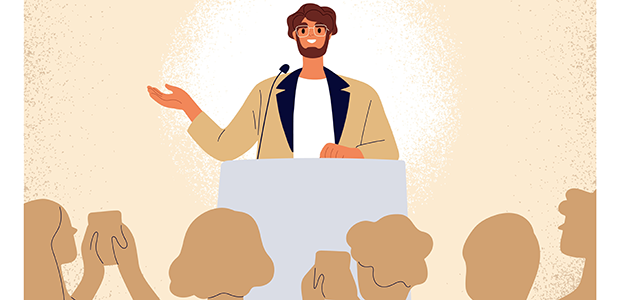
How to become a trusted and confident spokesperson for your organisation
A media interview is a crucial opportunity to get your message across. There are no second takes for a live broadcast, so it's essential that you're prepared for any scenario.
To help business professionals become more trusted and confident speakers, RADA Business’ expert Tutors Louise Collins, a qualified vocal coach, and Robert Taylor, a journalist, and media training specialist, share their insights on communication style, the importance of giving an authentic performance, and how these essential skills can be put to work.
Why is it so important to find your communication style?
“Everyone has a preferred way of communicating. Some people are naturally chattier and more relational, whereas other people are more logical and concise. There’s no right or wrong style. However, in a crisis interview a chatty style might not be the best choice! Alternatively, if you’re doing a promotional interview you may want to create enthusiasm and interest in your audience, and that will need to be heard in your delivery. In this case, logic and a flat tone would come across as detached and dry. If you can flex your style, you have a better chance of hitting the right tone and being more engaging,” says Collins.
“It’s best when people feel able to behave naturally on camera,” adds Taylor. “Some people find that easier than others, and you’ve got a real advantage if the viewer gets the feeling that the person they see on film is the same person that they could have a coffee with, for example.”
What is the effect of a good or bad performance in front of the media? Why is this skill so valuable?
For Taylor, he says: “It really comes down to this: are you hitting your business objectives? Your body, your voice and your words must align to give messages that help you achieve your business objective while meeting the journalist’s purpose. What you're looking for in an interview is giving the journalist a piece of news that is helpful, interesting, and engaging for the audience, while you as the spokesperson are driving the audience to action and achieving your business objective. It's about changing or reinforcing the way the audience thinks, feels, or behaves.”
“Being in front of a camera and challenged by a journalist is stressful”, adds Collins. “It can send people into behaviours that don’t show them at their best and can, therefore, derail their objectives. Some people might freeze and say very little, whereas others might find they’re talking and gesturing far too much. It depends on how this highly pressurised situation affects you.”
What one piece of advice would you give to someone required to talk to the media?
Collins says the key is preparation. “Preparation of both the content and the way you’re going to deliver those words.”
Taylor adds that for him, it's the 80:20 rule. “A novice interviewee often spends all their preparation time worrying about what the journalist is going to ask them, which is an unhealthy way to prepare. The best way to prepare is to spend 80% of your time on what you proactively wish to communicate: your two or three headline messages. And then 20% can be spent on thinking about what the journalist might ask, and how you would respond. The answers to the journalist’s questions may not be your key messages, but you’ve still got to give them – you shouldn’t dodge the question. I want people to be able to answer the question, and, if necessary, then bridge on to what you want to say. That’s utterly crucial, in any media interview.”
To handle even the toughest media interviews, you need the tools to speak with confidence and authority, at a moment's notice.
What do participants learn on the Voice of the Company: A Spokesperson’s Toolkit programme, and what distinguishes it from other media training programmes?
Taylor says the programme “gives people the tools, techniques, and confidence to become an effective spokesperson for their organisation. That could be through a face-to-face live TV interview, picking up the phone and talking to a local print journalist, or doing a video or audio podcast. It’s about getting your message across to the end audience through an intermediary: the media. That’s what distinguishes it from any other form of communication, and I think there are particular tools and techniques to deal with that in a way that you wouldn't if, for example, you were presenting directly to your audience. You're going through a prism.”
“The course takes place over two days”, adds Collins. “On day one we look at your communication skills. We drill down to the underlying elements that are required to give a successful media interview: the voice, gesture and body language that supports your words. On day two, we look at how to apply these skills to a variety of media interviews. Participants become aware of the physical nature of communication and how that translates in front of the camera. By developing vocal and communicative expertise you have more choices when it comes to responding to a journalist and, of course, your wider audience.”

